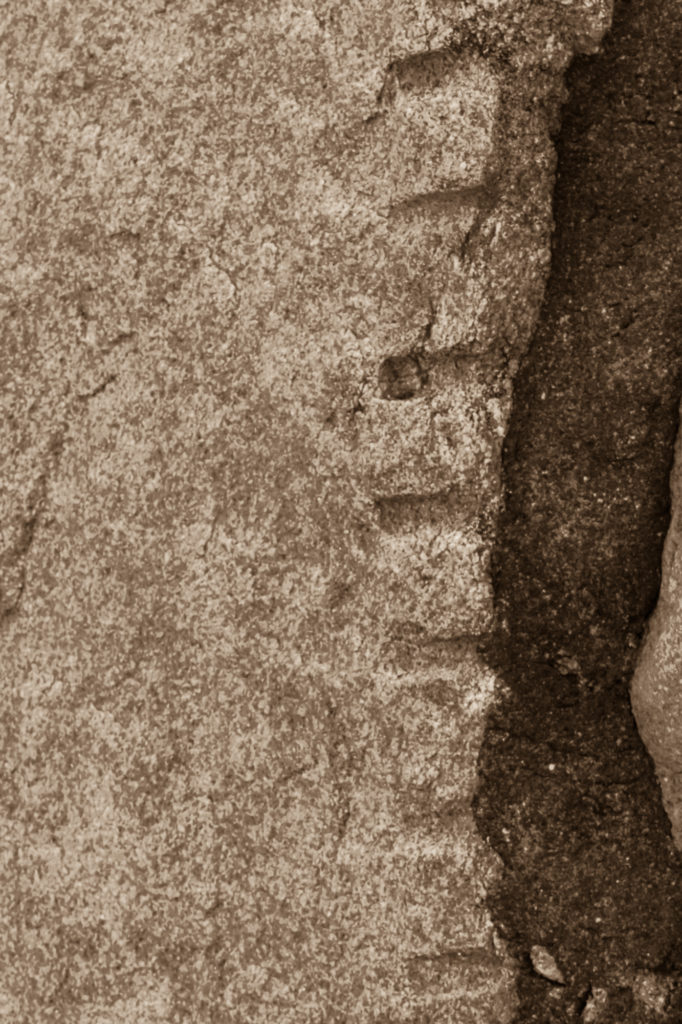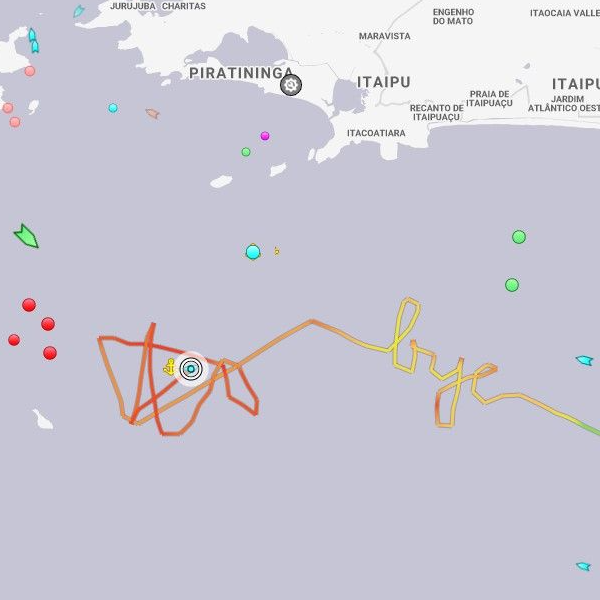‘Follow the cartouche!’ is not what you’d expect native American trackers to say but it’s one trick that The Shadow Wolves can use to find people who have crossed into Arizona from Mexico. It seems that our shoe brands in soft soils or sands are as useful as a wall for immigration control.

Nion over luis, ash over rowan?

Sadly, in a sign of the times, the geophysical company Polarcus ceased operations back in February when their creditors chose to sell the fleet. Polarcus Naila wrote the farewell message on departing Rio de Janeiro. (Image from MarineTraffic.com)
Martin Pirongs drew an outline of himself in London in 2019 in the style of Vetruvian man. He created his ‘M25 Man‘ by using GPS to track his hike of urban streets. He walked himself in 240 km over a period of ten days.
All three of these stories are of depictions of modern ephemera. I know of such because I can read, like you are doing now. I’m grateful to the many-someone-elses who invented all of the tools and techniques that can be bound together to enable me to read the minds of millions if not billions.
Some say that writing is the greatest invention in human history. It can be hard to ignore suggestions that the wheel or the clock vie for that distinction until you realise you are reading the advocacy for them.
We can agree, I hope, that all writing systems have one principle in common. Each conveys meaning through a mixture of phonetic and semantic symbols. The proportions vary and within the variations are a measure of phonetic efficiencies. Egyptian cartouches are pictures or logograms and knowing that a vulture represents mother puts you up the learning curve. But how would you pronounce it, vulture or mother? Enter the rebus, the form of pictogram that represents a sound rather than an idea. How well it conveys a message might depend on your skill with emojis. Oops, sound and ideas have just crossed over.
👋 😡 🌐 – hello mad world
😀 👤📖 – happy reading
What’s so useful about emojis is that they work in multiple languages. CU L8R doesn’t. No one really understands how the ancient Egyptians conversed or what it sounded like. They didn’t write their vowels very often. Clues have been taken from modern Coptic that retains a strong pharaonic inheritance. And the Babylonians borrowed so many words from Egypt that their vowel-inclusive tablets offer further insight. An American president is alleged to have said that the ‘problem with the French is that they don’t have a word for entrepreneur.’ But he should have known it’s a two street and what we lack is a word or phrase for ‘le weekend’.
I really liked the Ogham poem by Susan Connolly, Stone of Branogenus. But there are limits on what I can share without a scan or a photograph. Copyright aside, I can’t even show you the poem in ogham script because that font isn’t supported in WordPress. So here’s the English translation that I can’t lay it out like the poet did in her 2000 book Ogham. So by sharing it like this, I risk changing the essence of the poem, perhaps creating fake poetry. Derivatives and interpretations aren’t always right.
Ogham is climbed as a tree is climbed, treading on the root of the tree first, with one's right hand before one and one's left hand last
There used to be a lot more granite that made up a much bigger hill where I live in Killiney and Dalkey. It was quarried and transported and relaid as walls, paths, piers and more. The quarrymen used black powder to blast the rock faces into manageable blocks of stone. They drilled holes that are visible to this day on the pier in Dun Laoghaire. Hand augured holes remain in the rock faces in Dalkey quarry and others can be seen in various church and garden walls across many local and distant parishes.
I think the boreholes tell the beginnings of a story written on rock with black powder. A story you can embellish for yourself. How dusty would the air have become after every blast? Perhaps everyone wore grey clothes to mask the dust that fell onto the clothes hung to dry in the villages of Dalkey and Killiney. And I’ve seen the mangled and truncated limbs of former miners in Bolivia. One wonders about health and safety issues in the century of extractive operations that started around 1817, ending while 1917s’ slaughters commissioned epitaphed headstones for millions.
I really like the idea of mutable endings. Perhaps that’s because I’m a Piscean. An astrologer once told me my star sign made me adaptable, flexible and sympathetic (getting two out of three right isn’t bad). The astrologer worked hard but failed to convince me that my temperament and behaviour had long been written in the Zodiac.
I also like that endings can be reframed. Perhaps you know the story of the decipherment of Mayan glyphs. You may know that a Russian soldier called Yuri Knorosov was the key. He happened to be in Berlin in 1945 and on seeing the conflagration that was the National Library, he rescued one book from the flames. It was a one-volume, 1933 edition from Guatemala about the codices of the Maya. I don’t know that Yuri read Latin script let alone understood Spanish but he published the critical decipherment breakthroughs, in Russian, in the 1950s.
That’s how we know the conquistadores who named the Yucatán got it wrong. They beached and doubtless asked a Mayan to confirm their location. The reply was ‘uic athan’ which means ‘what do you say, we don’t understand you’. Not much later, the vicious Spaniard, Bishop Landa, became a Mayan language scholar. He had personally overseen ruthless suppression of Mayan culture and used popular inquisition techniques to forcefully convert survivors to Catholicism. He misunderstood much and one of the most famous is a written response to his a request for more information: properly translated in the 1950s it read ‘I don’t want to’. Was it an epitaph to religious zealotry hidden in plain sight for four centuries?
Further reading:
The Story of Writing by Andrew Robinson (1994)
Ogham by Susan Connolly and Anne-Marie Moroney (2000)

Leave a Reply